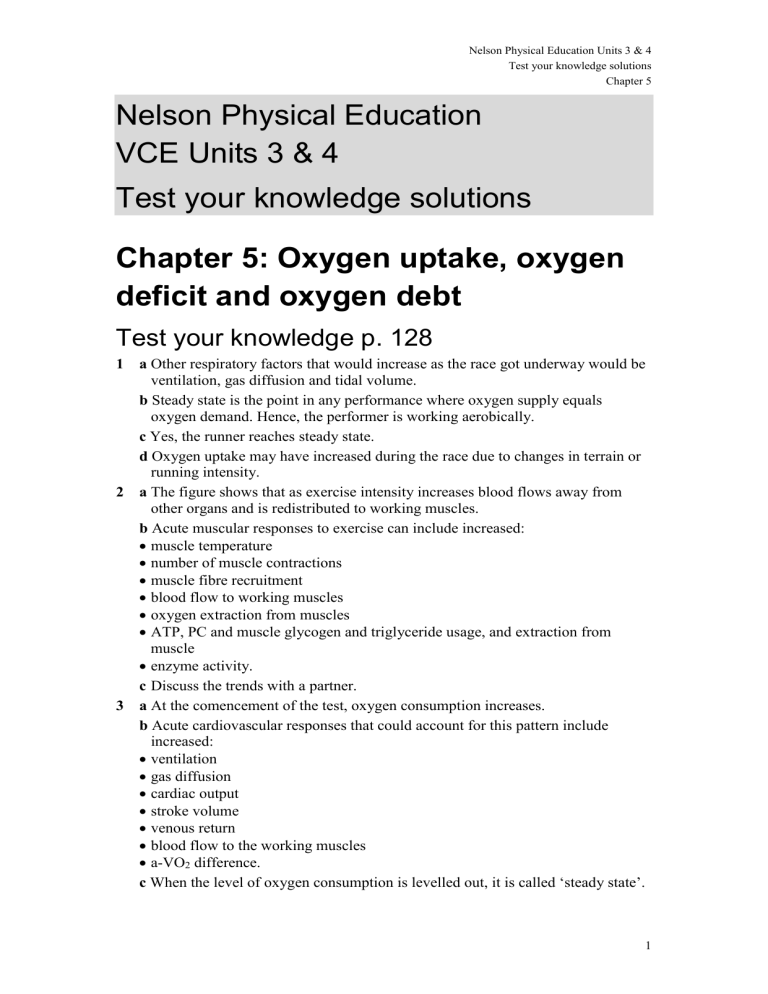Physical Education VCE Unit 3

Nelson Physical Education Units 3 & 4
Test your knowledge solutions
Chapter 5
Nelson Physical Education
VCE Units 3 & 4
Test your knowledge solutions
Chapter 5: Oxygen uptake, oxygen deficit and oxygen debt
Test your knowledge p. 128
1 a Other respiratory factors that would increase as the race got underway would be ventilation, gas diffusion and tidal volume. b Steady state is the point in any performance where oxygen supply equals oxygen demand. Hence, the performer is working aerobically. c Yes, the runner reaches steady state. d Oxygen uptake may have increased during the race due to changes in terrain or running intensity.
2 a The figure shows that as exercise intensity increases blood flows away from other organs and is redistributed to working muscles. b Acute muscular responses to exercise can include increased:
muscle temperature
number of muscle contractions
muscle fibre recruitment
blood flow to working muscles
oxygen extraction from muscles
ATP, PC and muscle glycogen and triglyceride usage, and extraction from muscle
enzyme activity. c Discuss the trends with a partner.
3 a At the comencement of the test, oxygen consumption increases. b Acute cardiovascular responses that could account for this pattern include increased:
ventilation
gas diffusion
cardiac output
stroke volume
venous return
blood flow to the working muscles
a-VO
2
difference. c When the level of oxygen consumption is levelled out, it is called ‘steady state’.
1
Nelson Physical Education Units 3 & 4
Test your knowledge solutions d Steady state is the point in any performance where oxygen supply equals oxygen demand. Hence the performer is working aerobically.
Chapter 5 e Lactid acid accumulation would not occur at times of steady state. f The lactid acid accumulation would not occur because the athlete would be working aerobically and additional lactic acid would not be produced. g Oxygen consumption remains elevated (4 litres/min) at the end of the exercise and is higher than oxygen consumption at rest (0.5 litres/min). h The student’s oxygen levels may have remained high because additional oxygen is needed for recovery of energy systems, restoration of creatine phosphate stores, conversion of lactic acid to pyruvic acid and conversion of pyruvic acid to glucose in the liver. The pattern shown in the figure represents the oxygen debt – the volume of oxygen used during recovery from exercise in excess of resting oxygen consumption.
4 a Oxygen consumption remains elevated (2 litres/min) at the end of exercise (in the first minute of recovery) and is higher than oxygen consumption at rest (0.5 litres/min). b In order for oxygen consumption to increase, cardiovascular responses that must occur are increased:
ventilation
gas diffusion
cardiac output
stroke volume
venous return
blood flow to the working muscles
a-VO
2
difference. c Within the the first 2.5 minutes of exercise, oxygen uptake rises rapidly from 0.5 litres/min to 2 litres/min. At the 5 minute mark of exercise the oxygen uptake remains steady at 2 litres/min until exercise concludes. d
‘A’ should be placed at the commencement of exercise oxygen deficit. ‘B’ should be placed in recovery oxygen debt.
2









